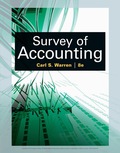
Concept Introduction:
The
Requirement-1:
To Indicate:
If it is permissible to record additional
Concept Introduction:
The Balance sheet is a summary of Assets, Liabilities and equity accounts that reports the financial position of the business as on a specific date. Assets are further classifies into Current Assets, Long Term Investments, Plant Assets and Intangible assets. And Liabilities are further classified into Current Liabilities and Long term liabilities.
Requirement-1:
To Indicate:
If it is permissible to record additional depreciation if the asset is useful
Concept Introduction:
The Balance sheet is a summary of Assets, Liabilities and equity accounts that reports the financial position of the business as on a specific date. Assets are further classifies into Current Assets, Long Term Investments, Plant Assets and Intangible assets. And Liabilities are further classified into Current Liabilities and Long term liabilities.
Requirement-2:
To Indicate:
The time when the cost and the
Want to see the full answer?
Check out a sample textbook solution
Chapter 7 Solutions
Survey of Accounting (Accounting I)
- General accounting questionarrow_forwardOn January 1, 2022, Hoda Corp. sells a piece of equipment for $31,000. The equipment was originally purchased on January 1, 2020, for $56,000. The equipment was estimated to have a useful life of 4 years and a residual value of $0. Hoda uses straight-line depreciation. How will Hoda record this transaction?arrow_forwardWhat is the firm's total liabilities?arrow_forward
